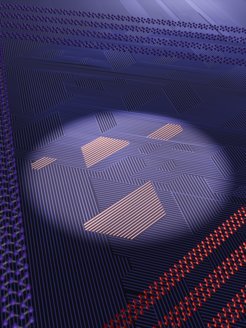Light switches between electronic states with spatial precision
Researchers from Göttingen and Marburg have succeeded in using light to specifically change the electronic state of a material. Their results show how ultrashort light pulses can switch nanoscale areas of a material between insulating and metallic states – precisely and without significant heat input.
Some materials can be metals or insulators depending on their temperature.
Researchers have succeeded in controlling electronic phases in tiny areas of a material by means of light polarization.
The technology promises innovations for novel electronic circuits.
Some materials are metals, others are insulators, and still others can be either depending on the temperature. When the transition between these states is sensitive to local inhomogeneities, they often coexist spatially in tiny domains. Although this coexistence often determines the electronic properties, it has not been possible to generate it in a controlled manner until now. It was already known that light can be used for switching between the insulator and metal states. A team from the Max Planck Institute (MPI) for Multidisciplinary Sciences, the University of Göttingen, and the University of Marburg has now succeeded in controlling these states with spatial selectivity. The researchers have published their findings in the journal Nature Physics.

For their experiments, the researchers used indium nanowires on a silicon surface. In the model structure, electrons can flow freely along the atomic wires, but not perpendicular to them. “First, we investigated how the wavelength and polarization of light influence the material,” explains Hannes Böckmann, postdoctoral researcher in Claus Ropers’ Department of Ultrafast Dynamics at the MPI for Multidisciplinary Sciences and first author of the study. “Then we realized that certain combinations could also allow nanowires with different orientations to be selectively addressed.”
The key feature: Instead of heating up the entire material with strong radiation and thus switching it globally, the researchers explicitly excited only a very specific part of the electrons along the atomic chains. This enables high spatial control of nanoscale areas with different orientations. “We were able to show that electronic phases can be specifically designed with light,” says Böckmann and emphasizes: “This opens up completely new possibilities for future components in which light polarization controls the electronic properties of a material.” In the long term, this technology could contribute to developing novel electronic circuits whose functionality can be manipulated by light. (hb)









